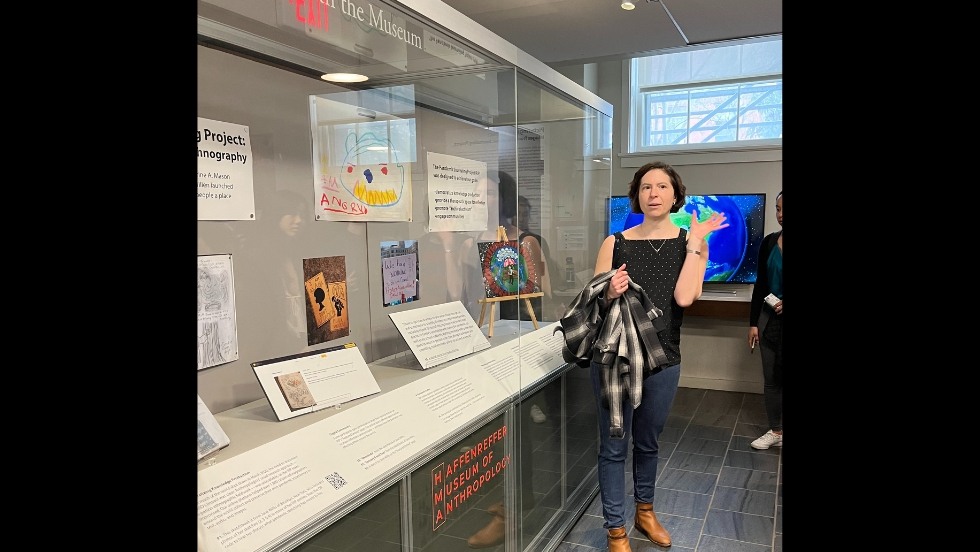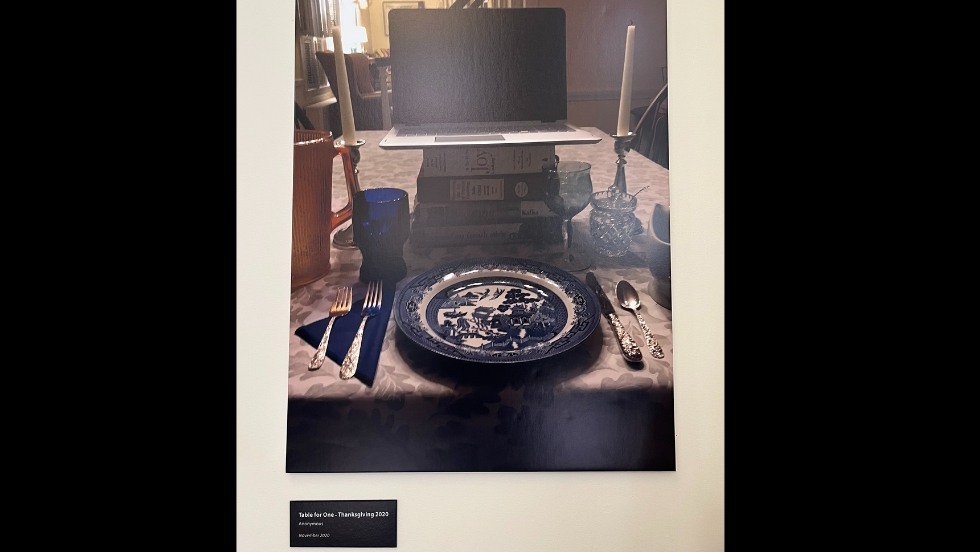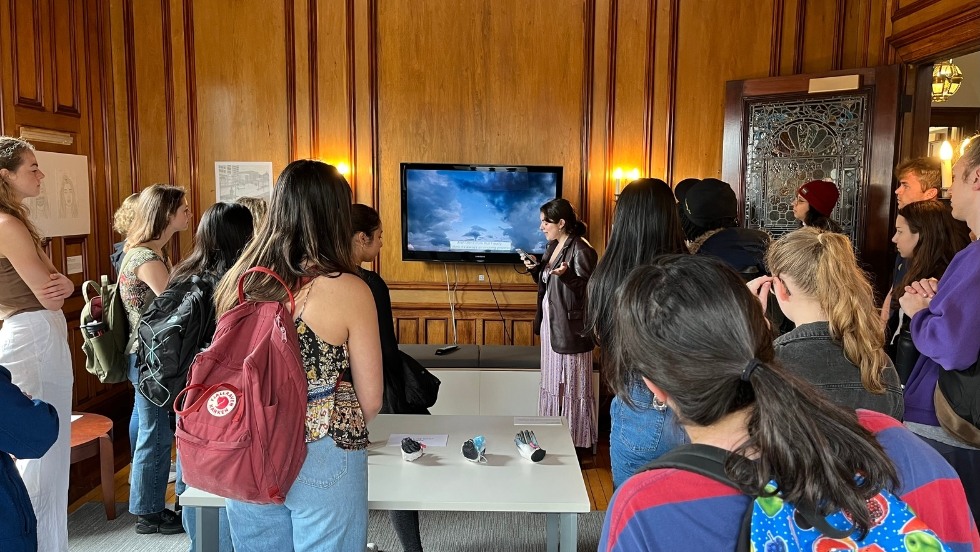Imagine having a child in a world shuttering its doors and mandating six-feet of distance between you and another human being at all times. Now, imagine celebrating Thanksgiving with your family but instead of sitting side-by-side, you talk to one another through a computer screen. What was that like?
On Thursday, April 6th, students in Katherine Mason’s ANTH 1515: Anthropology of Mental Health course led a walking tour of three on-campus sites for the traveling exhibition, “Picturing the Pandemic: Images from the Pandemic Journaling Project.” The exhibition stems from the Pandemic Journaling Project, an initiative co-founded by Mason and her colleague Sarah S. Willen, Associate Professor of Anthropology at the University of Connecticut, to allow ordinary people a place to chronicle and preserve their pandemic experiences. Today, more than 1,800 people in 55 countries have created nearly 27,000 individual journal entries. The tour group on April 6th were joined by Mason and other community members, including the curators of the main exhibition site at the Providence Public Library, Christina Bevilacqua and Sophia Ellis.
The first stop on tour led the group to Stephen Robert ‘62 Campus Center. This location, titled "The Pandemic Journaling Project: A Grassroots Collaborative Ethnography" highlights why and how the Pandemic Journaling Project was created, how online journaling works as an ethnographic methodology, the project’s international reach, and the overall outcome of the initiative as assessed by its co-founders. A large glass case with Haffenreffer Museum of Anthropology displayed on the front serves as a main focal point in the bustling space. Inside the case is an abundance of images, text, and objects from the project, including a sketchbook from Jane Willis of Brooklyn, New York. Willis submitted weekly online entries to the Pandemic Journaling Project from spring 2020 through spring 2022 — often creating drawings in the sketchbook to accompany her entries. A QR code inside the case lends to a recording of Willis describing what pandemic sketching meant to her.
The next stop brought the tour to the Population Studies and Training Center (PSTC). Upon entering Mencoff Hall, visitors are greeted by a room full of photographs. This exhibition location focuses exclusively on population health-related themes such as public reactions to control efforts and fertility during the pandemic. Mason and her students gathered around a wall featuring multiple images of a woman and her newborn in the hospital. “She was having a really hard time,” explained Mason. The woman had documented and shared her first days postpartum as the world around her shut down — her images now sealed in time by the Pandemic Journaling Project.
Across the room in Mencoff, another series of photographs takes visitors on a journey through the hardships of family life during the pandemic. One of Mason’s favorite images is a sight many are familiar with. A MacBook sits atop a pile of books with taper candles on each side. “Zoom Thanksgiving!” she laughs. “We all know what that felt like.”
The third and final stop on the campus exhibition tour, the Swearer Center, was especially meaningful to Mason and her class. Students were divided into separate groups to focus on one of two topics related to mental health: art or policy. Members of the art group created physical renderings of their pandemic experiences that spoke in some way to Pandemic Journaling Project materials.
The policy group worked to create a social media campaign and policy brief for an important bill related to mental health in the state of Rhode Island. Caleb Ellis ‘24 and Emma Keuler ’24 are two students in the ANTH 1515 policy group working tirelessly to meet with Providence residents to collect information on their experiences with mental health accessibility in the state. They also sent out surveys to local businesses and community groups explaining the lack of current mental health accessibility and the dire need to create a financially affordable solution. In the final weeks of class, Caleb, Emma, and their peers will write a policy brief on why the bill is beneficial and should be considered by lawmakers.
The art component of the class allowed a group of students to choose an existing piece of material from the Pandemic Journaling Project to expand on and personalize based on their own experiences. Some chose a lighter perspective, while others used paint and clay to depict what was lost during the pandemic — both literally and figuratively. Luke Horton ‘24 created a painting dubbed “Haunted Zoom,” representing the transition to digital media when social distancing was at its peak. “Covid-19 caused many to become very familiar with the software, Zoom, which was used as a means to stay connected during a time of disconnect,” Horton remarked. His piece features a Zoom call filled with ghosts in various, relatable positions. On the top left: a bad camera angle. To the right: someone creeping by in the background of the call. The third ghost is seemingly paying attention, but a closer look (and reflection in their glasses) reveals that they are actually surfing the web.
A few students in the art group chose to show how the pandemic affected a much younger generation. A painting on the back wall of the Swearer Center put together by Czenil Santander ‘23 and elementary school students at William D’Abate Elementary in Providence reveals colored handprints with a key to determine what each color represents. The handprints belong to participating children who were asked to choose a color defining an emotion they had during lockdown. The colorful painting showed a variety of moods — sad, angry, or confused, but a few yellow hands represented happiness. When Santander asked the children why they chose happiness as their emotion, they replied, “Because I didn’t have Covid.”
Other pieces produced by the ANTH 1515 art group included two digital images created by Anasemi Owate-Chujor '23.5 representing the emotional grip of isolation during lockdown, something she compared to asphyxiation. Shelby Kostal ‘23 sculpted a “tea party for one” out of clay, which she purposely left unfired by a kiln. She explained how her family was forced to give up their weekly tea together as a result of social distancing. “I really liked the idea of leaving the clay unfinished,” she told the group. “That way it can be shaped and molded into something entirely different and repurposed, similar to how many things felt renewed after the pandemic.”
The three on-campus exhibition sites serve as a visual time machine, looking back on the variety of ways the pandemic affected people around the world and allowing visitors to process relatable experiences. The Pandemic Journaling Project provided a therapeutic outlet for individuals to express their feelings and experiences through writing, art, or verbalization. It serves as a reminder that we are not, and never were, alone.
Learn more about "Picturing the Pandemic: Images from the Pandemic Journaling Project"






